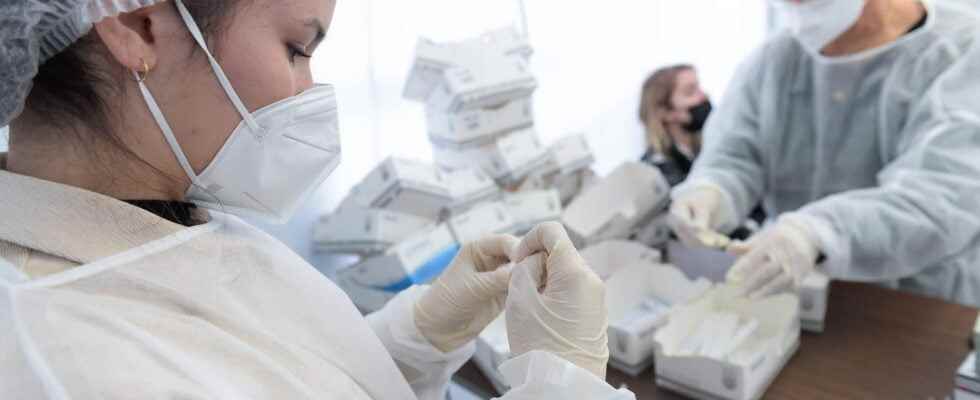The BA.2 variant, Omicron’s little brother questions. The mutation could infect people previously infected with Omicron, but there is no indication of greater danger.
[Mis à jour le 26 janvier à 17h46] A newcomer is added to the list of the many variants of Covid-19. The BA.2 mutation is attracting attention as the peak of the Omicron wave, initially expected for mid-January, has still not been crossed and the number of new daily contaminations is approaching record levels. The BA.2 variant is actually a sub-variant of Omicron, so it has many similarities and is difficult to identify. “It has the color, taste and smell of Omicron but is not exactly like him”, described Olivier Véran on LCIon Tuesday, January 25.
The first results of the sequencing of the mutation revealed many similarities between the BA.2 and Omicron variants but also a notable difference on the Spike protein which determines the contagiousness of the virus but also the effects of the immune response enabled by the antibodies. Among these peculiarities, one could prevent “human cells [de] to acknowledge [le variant]even though they would have already been exposed to the Omicron variant”, according to the explanations of Olivier Véran. These first elements of response suggest that the contagiousness of the sub-variant is greater. “BA.2 seems to be transmitted more easily” , confirmed Troels Lillebaek, the Danish epidemiologist and director of the director at the Statens Serum Institut, on BFM TV. But the real question surrounding the BA.2 mutation “is knowing how serious it will be”, insisted Jean-François Delfraissy, president of the Scientific Council, on France info, also on January 25. If on this point the mystery still remains intact, Olivier Véran affirmed that BA.2 is “no more dangerous” than Omicron. Studies are continuing to better understand this Omicron sub-variant and its characteristics, especially since another question is bothering the scientific community: “We do not understand why this sub-variant, which appeared more than two months ago, becomes suddenly dominating in Denmark”.
When did the BA.2 variant appear?
The BA.2 subvariant is an evolved form of the BA.1 mutation commonly referred to as Omicron. If the oldest genomic sequence of Omicron dates from October 25, 2021, that of BA.2 only appeared a week later, on November 1. Despite this sequencing, the submutation was only really identified on December 7 and it took even longer before it reproduced on a large scale, to the point of becoming the majority in Denmark. The Nordic country is the one where the BA.2 variant circulates the most. It already accounts for 66% of Covid-19 cases. The mutation spread like wildfire in just a few weeks, it accounted for 20% of all Covid-19 cases in Denmark during the week of December 27 to January 2, and 45% during the week from January 10 to 16, according to data from the Statens Serum Institut.
Does the BA.2 variant circulate in France?
Coming from Omicron, the BA.2 mutation is likely to spread in France. As of January 25, only 60 contaminations were due to the new variant according to the Minister of Health. In reality, it is impossible to count the number of cases of BA.2 because “the detection of mutations of the SARS-CoV-2 by screening does not allow, in most laboratories, to distinguish BA.1 from BA.2 “explained the biologist Florence Débarre, at the World. It would be necessary to modify the targets of the screenings or to sequence the entire viral genome to identify the nature of the variant, but “the reporting of sequencing data in France is not immediate”.
Is the BA.2 variant more contagious?
The surge in the number of daily contaminations in Denmark coincides with the proliferation of the BA.2 variant on the territory and Danish scientists evoke the hypothesis of an increased transmissibility of the new mutation. An opinion joined by Jean-François Delfraissy who described, on Franceinfo on January 25, the BA.2 as “a little cousin of Omicron, even more transmissible”. Etienne Declory, virologist at the CNRS of the University of Aix-Marseille, tempers this speech and recalls that it is “far too early” to draw conclusions. The specialist is content to affirm that the variant “BA.2 carries fewer mutations than BA.1, in particular on the Spike protein”. The few differences observed between BA.1 and BA.2 relate more to the ability to create a neutralizing immune response to the virus.
What are the differences between the BA.2 variant and Omicron?
The Omicron variants, or BA.1, and BA.2 belong to the same family of mutations, BA.2 would even be an evolution of Omicron. Essentially the two mutations are similar but the virologist Etienne Decroly noticed that “BA.2 carries fewer mutations than BA.1, in particular on the Spike protein”. The Spike protein is particularly watched since it concentrates the characteristics linked to contagiousness and the triggering of an immune response. In detail, the scientist explains that on the “furin cleavage site” and the RBD (receptor binding domain) site, which respectively affect the virus’s ability to infect human cells and trigger a neutralizing antibody response, no significant difference of BA.2 compared to Omicron is to be noted. On the other hand, on the NTD domain, “N-terminal domain”, plays a role in the activation of neutralizing antibodies, notable differences have been identified and suggest that antibodies created to fight against Omicron would not be able to bring an immune response against the BA.2 variant. In other words, a person already infected with Omicron could still be infected with the BA.2 sub-variant.
If the risk of being infected with the BA.2 variant exists even after contamination with Omicron, the mutation would not be the cause of a serious form. As with its elder, BA.2 could therefore be more contagious but less dangerous and send fewer patients to hospital. The director of the Danish research institute, Troels Lillebaek, indicated on BFMTV: “Preliminary indicators show that there is no difference between BA.1 and BA.2 for hospitalizations, that there is no no more virulent”.
